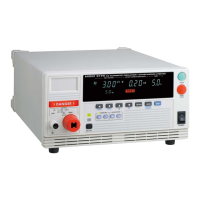9.3 Communication Methods
129
99
Headers
Headers must always be prefixed to program messages.
Command Program Headers
There are three types of commands: Simple, Compound and Standard.
•
Headers for Simple Commands
This header type is a sequence of letters and digits
∗
ESE 0
• Headers for Compound Commands
These headers consist of multiple simple command type headers separated
by colons ":"
:WITHstand:CLOWer
• Headers for Standard Commands
This header type begins with an asterisk "∗",
indicating that it is a standard command defined by IEEE 488.2.
∗
RST
Query Program Header
These commands are used to interrogate the instrument about the
results of operations, measured values and the current states of
instrument settings.
As shown by the following examples, a query is formed by appending a
question mark "
?" after a program header.
:MODE?
:WITHstand:CLOWer?
Message Terminators
This instrument recognizes the following message terminators:
From the instrument's interface settings, the following can be selected as the ter-
minator for response messages
See "9.2.2 Setting the Communication Conditions" (p. 125)
There is a need to add “:” to the front of the command except standard com-
mands in the instrument.
•LF
• CR+LF
•EOI
•LF with EOI
•CR
• CR+LF
• LF with EOI (initial setting)
• LF with CR and EIO
• CR+LF

